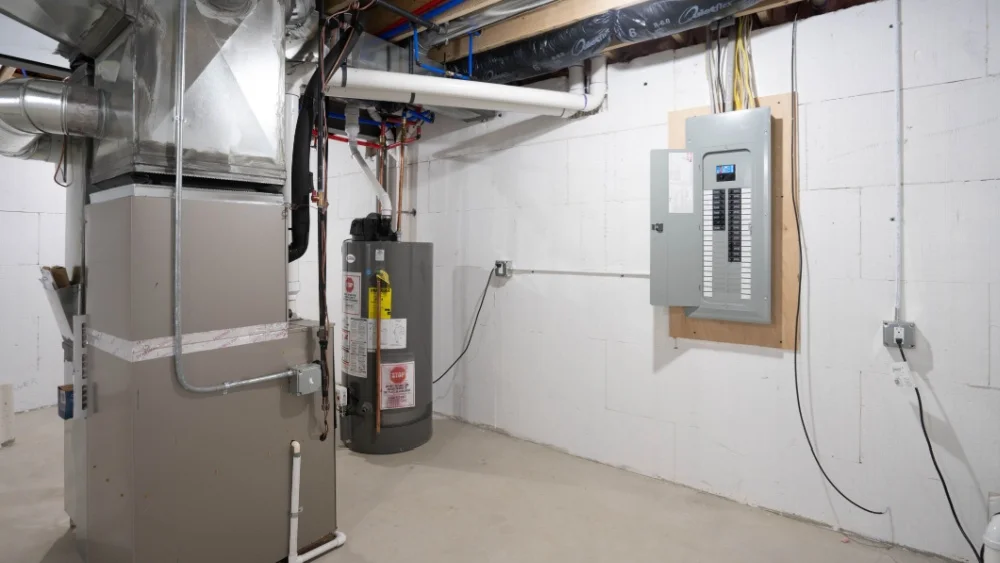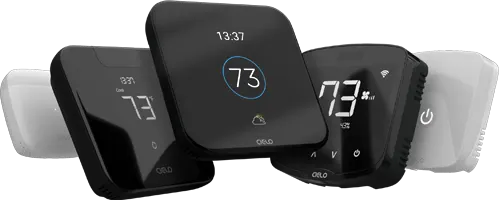
Key Takeaway
- Furnaces are categorized by fuel type (gas, electric, propane, oil, and wood) or heating capabilities (single-stage, two-stage, and modulating).
- High-efficiency furnaces with AFUE ratings between 90% and 98.5% consume less energy, helping to reduce heating costs.
- Check fuel availability, home size, local climate, and budget to select the best furnace for your home.
When it comes to heating your home, choosing the right furnace is essential for ensuring comfort, energy efficiency, and cost savings. With various options available, it’s important to understand the different types of furnaces and how they operate. Each type is built with unique features to cope with different needs and climatic conditions.
Whether you’re looking for a basic, budget-friendly option or a high-efficiency system that provides consistent warmth, this blog will guide you through the various types of furnaces and highlight their differences to help you make an informed decision.
How Does a Furnace Work?
Furnaces are forced-air systems that generate heat by burning a fuel source like oil, propane, or gas. The heat exchanger uses that heat to warm the air, which is then pushed through the ducts and into your home via a blower. All the by-products, like carbon monoxide, produced in the combustion process are expelled via the furnace’s flue pipes.
There are many different types of furnaces in the market. Some are categorized by their fuel source, others by their heating capabilities.
Furnace Types by Fuel
There are five main types of furnaces that are differentiated by their fuel source:
Gas Furnace
A natural gas furnace is a popular choice for home heating, especially in regions with very cold climates and low gas prices. It works by using a flame to heat a heat exchanger, which transfers the heat to incoming air.
Though their initial cost ranges from $3,800 to $10,000, they are often cheaper to run over time than other heating systems. To install them in your home, you will require access to a gas line. Furthermore, you will need to maintain your gas furnace over time and ensure that there are no CO2 leaks.
| Pros | Cons |
|
|
|
|
|
|
Electric Furnace
Another common furnace choice is the electric furnace. Unlike a gas furnace, it does not use an open flame. Instead, the system pulls the surrounding air inside and heats it using electrical elements before blowing it through the ducts into your home.
It is a safer option than other furnaces, as there is no risk of gas leakage. Plus, it’s more environmentally friendly, as it doesn’t burn fossil fuel to generate heat.
Electric furnaces lower installation costs, ranging between $2,000 to $8,000, but they have higher operating costs in the long run.
| Pros | Cons |
|
|
|
|
|
Propane Furnace
Propane furnaces operate very similarly to gas furnaces; however, they use propane instead of natural gas. They are mostly used in areas without access to natural gas lines. These furnaces cost around $2,200 to $7,400.
It works by converting liquid propane into gas, which passes over a heat exchanger to warm the air. The hot air is then distributed throughout your home.
You can choose from various fuel tank options, such as smaller 20-pound tanks or larger tanks ranging from 500 to 2000 pounds, which can last for months without needing a refill. Although propane is more expensive than natural gas, propane furnaces use the fuel so efficiently that they become more cost-effective over time.
| Pros | Cons |
|
|
|
|
|
|
Oil Furnace
Oil furnaces, like propane furnaces, require fuel tanks. These tanks are filled with fuel oil, which is similar to diesel gas. Some models even use kerosene as the fuel source. These types of furnaces generally require more maintenance than others, and the higher fuel prices may make them an expensive alternative. The average cost of an oil furnace is $2,500 to $10,000.
It generates heat by using a burn chamber. Here, the fuel brings oil to the chamber, which is turned into a fine mist. This mist is sprayed onto a burner, which heats up the incoming air. The heated air is then distributed throughout the home via the duct system.
| Pros | Cons |
|
|
|
|
|
|
Wood Furnace
Wood-burning furnaces are powered by firewood or wooden pellets. They use burning wood to generate the heat that warms up the air. All wooden furnaces have some kind of exhaust flue to vent out smoke. They are also less efficient than their counterparts. They range between $8,000 and $20,000.
| Pros | Cons |
|
|
|
|
|
|
Furnace Types By Heating Capabilities

There are three main types of furnaces in this category:
Single-Stage Furnace
Single-stage furnaces are the most conventional type of furnace. They operate in just two modes: fully on or off, running at 100% capacity when heating. Therefore, they do not offer the flexibility to adjust to changing outdoor temperatures. Their prices range between $700 and $3,000.
| Pros | Cons |
|
|
|
|
|
|
Two-Stage Furnace
A two-stage furnace has three operating modes—off, high, and low. This sophisticated approach allows you to save energy and adjust the heat output according to your heating needs and weather conditions. In moderate climates, the furnace can work in low power mode, while in harsher, cold climates, it can work in high mode. The price typically ranges between $1,000 and $3,500.
| Pros | Cons |
|
|
|
|
|
|
|
Related: Single-Stage vs. Two-Stage Furnaces: Major Differences, Pros & Cons
Modulating Furnace
Modulating furnaces are the advanced systems that provide even more consistent heating than the two-stage furnaces. They work by adjusting the flame in small increments to regulate your home’s temperature, minimizing fluctuations and ensuring a more precise comfort level. These furnaces can range between $1,300 and $6,500.
| Pros | Cons |
|
|
|
|
|
Factors to Consider When Choosing a Furnace
When choosing a furnace, consider the essential features that best suit your home’s needs:
- Size: When choosing a heating system, consider your home’s square footage, insulation quality, and ceiling height.
- Fuel Type: Decide between gas, electric, propane, or oil, depending on availability and operating costs.
- Local Climate: Choose a furnace type optimized for the specific weather conditions in your region.
- Energy Efficiency: A furnace’s energy efficiency is measured via AFUE (Annual Fuel Utilization Efficiency) ratings. These ratings measure how efficiently a heating system uses fuel. Mid-efficiency units range from 80% to 88%, while high-efficiency models range from 90% to 98.5%.
- Extra Features: Upgrades like smart thermostats and noise reduction features add convenience and improve your indoor climate.
- Warranties: Consider installation warranties as an added layer of protection to supplement the manufacturer’s warranty.
Equip your HVAC system with smart features and achieve the perfect balance between comfort & savings.
Learn more
Which Type of Furnace Is Right for Your Home?
Choosing the right furnace for your home depends on your needs, budget, and local climate. With options like gas, electric, oil, and propane, each type offers unique advantages. For a cost-effective solution, a gas furnace is ideal if gas is inexpensive in your area. If you prefer consistent temperatures and high energy efficiency, a two-stage or modulating furnace is a great choice, though it comes with a higher initial cost. Additionally, factors such as size, efficiency, and additional features like extended warranties can help tailor your decision. Whether you prioritize lower operating costs, environmental friendliness, or specific heating capabilities, understanding the different furnace types ensures you make an informed decision to keep your home warm and comfortable.
Frquently Asked Questions
What Are Some of the Advanced Technologies in Modern Furnaces?
- Condensing Technology: Extracts more heat from exhaust gases via a secondary heat exchanger, boosting fuel efficiency.
- Variable Speed Blower: Traditional blowers run at full speed and have only an on/off option. A variable-speed blower runs at low speed and only increases the speed when your HVAC system needs extra power to deal with extremely cold weather. This leads to high energy efficiency, as your furnace isn’t starting and stopping more often.
- Electronically Commutated Motors (ECM): Furnaces equipped with ECMs (Electronically Commutated Motors) are about 20% more energy-efficient than traditional models. Unlike conventional motors that use mechanical brushes to transmit electrical signals, ECMs are brushless. This design eliminates the wear and tear that brushes typically experience, making ECMs less prone to failure.
- Electronic Ignition: Pilot lights are a thing of the past. Modern ignition systems light up gas using a spark or a hot surface. This improves energy efficiency and contributes to higher AFUE (Annual Fuel Utilization Efficiency) ratings as it eliminates fuel wastage by running a constant pilot flame.
- Modulating Gas Valve: It adjusts the amount of gas flowing to the burner, allowing the flame to increase or decrease as needed.
What Is the Most Common Type of Furnace?
Natural gas furnaces are the most widely used and oldest type of furnace. Their popularity stems from their efficiency, ability to heat homes quickly, and lower operating costs compared to electric furnaces.
What Type of Furnace Lasts the Longest?
Oil furnaces are known for their exceptional durability, often outlasting other furnace types. With proper care and regular furnace maintenance, an oil furnace can operate efficiently for up to 25 years. In comparison, gas furnaces generally have a shorter lifespan, typically lasting around 15 years and, with excellent upkeep, occasionally reaching up to 20 years.








